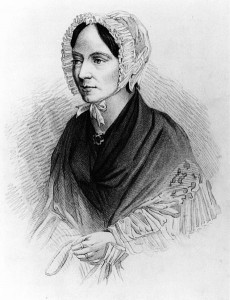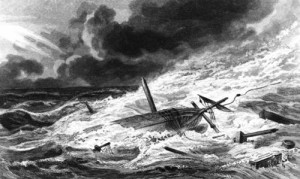 Eliza Fraser’s survival and rescue after being ship-wrecked on the island that carries her husband’s name are well-documented. The historical record shows that the Petries met Eliza and her husband Captain James Fraser on the Stirling Castle on the way to Australia from Scotland in 1831. In Turrwan I recount that Mary Petrie and Eliza became friends on the long voyage to Sydney. What follows is a section I cut from the book as it was getting too far away from the main storyline. Tom Petrie is with his mother Mary saying goodbye to the Frasers as they set out on their ill-fated voyage.
Eliza Fraser’s survival and rescue after being ship-wrecked on the island that carries her husband’s name are well-documented. The historical record shows that the Petries met Eliza and her husband Captain James Fraser on the Stirling Castle on the way to Australia from Scotland in 1831. In Turrwan I recount that Mary Petrie and Eliza became friends on the long voyage to Sydney. What follows is a section I cut from the book as it was getting too far away from the main storyline. Tom Petrie is with his mother Mary saying goodbye to the Frasers as they set out on their ill-fated voyage.
Eliza Fraser would also lose a baby, and more, several years after our arrival in Sydney. On a bright sunny day in 1836 I went to the wharf with Mother to say goodbye to the Frasers, who were sailing with the tide on the Stirling Castle, the same boat that had brought us from Scotland. In the midst of the bustle, Mother embraced Eliza awkwardly, the girl’s huge belly getting in the way. The tears flowed freely as the two women parted.
“Now you take care of yourself and the little one, you hear?” Mother ordered between sobs.
“You’re a born worrier, Mary. Everything will be just fine, you’ll see,” said Eliza, trying to lighten her departure. But everything would not be fine.
Eliza’s husband James stood beside her. Some twenty years her senior, he was in poor health and looked like an old man. He was extremely thin and wiry; Mother wondered how he wasn’t blown away when he was on deck. His dark mahogany face wore the signs of an unknown disease he had caught on one of his voyages to the southern seas. How he managed to run the ship was another mystery to Mother until she knew the man better. Fraser had a will of steel and had learned to live with the aches, pains and limitations of his malady. He still had his sea legs though and they carried him on his daily rounds of the ship. His second in command was a competent mariner and could be trusted to keep the ship in good order and on course.
James tried to spend as much time as he could spare with his beautiful young wife, still surprised that she had chosen to marry him when she had the pick of some of the most eligible bachelors in the land. Mother had asked herself the same question when she was introduced to Eliza at the Captain’s table on the Stirling Castle.
Eliza detached herself from Mary and waddled up the gangplank on the arm of her spouse, who ordered the crew to cast off as soon as his feet hit the deck; the tide would not wait. Mother wrung her hands on the dock, unable to shrug off the sense of uneasiness she felt about this trip. The boat drifted with the current, men scurrying aloft in the rigging, the sails unfurling with a flap in the light breeze. Eliza gave a last wave to the blurry figures on the wharf and turned to see the ship thrusting towards the Heads and the open sea.
Mother heard the full story of what happened next from Eliza when she eventually returned to Sydney. On their way north they called in at Dunwich on Stradbroke Island to offload some supplies for the settlement at Brisbane. A few days after leaving Moreton Bay, the Stirling Castle ran into a storm. Eliza was propped in her bunk, surrounded by cushions as the ship heaved and slewed, at times falling through the air to slam with a terrific thud on the surface of the ocean. Eliza thought they would all drown, but the sturdy boat managed to rise again on the next wave. Fixed to the foot of the bed was a bucket that Eliza had used until there was nothing left to bring up, her retching upsetting her baby, who pommelled her insides in protest.
Captain Fraser was also bedridden, assailed by an excruciating headache, when he felt the sickening crunch of the hull against the unforgiving jagged reef. He leapt to his feet, the pain forgotten as he donned his vest and struggled to his wife’s side. Eliza’s eyes were wide with terror as James made a feeble attempt to reassure her that the ship was solid. Then he cried “I have to go aloft,” and staggered out of the cabin.
“There was nuthin’ I could do Cap’n,” the mate bewailed when Fraser joined him at the wheel. “The bloody wind is too strong and has blown us way off course,” he went on, assuming no blame for their dire situation.
With an unearthly wrenching sound, the mainmast snapped and plunged into the sea, dragging the ship dangerously low in the water. The pounding waves would soon make mincemeat of their craft which was firmly wedged on the reef, Fraser decided.
“Ready the lifeboats, man. And get the crew on deck. Be quick about it, we don’t have much time.”
With the aid of a sailor, Fraser managed to manoeuvre his badly afflicted wife into one of the longboats where she cowered between the seats in a grey huddle as the rain lashed her face. Against the odds, most of the crew got off the doomed ship. As the storm abated, they set sail towards the south.
The first contractions shook Eliza when the lifeboat hit the water and bobbed like a cork in the tempest. In the small flimsy craft, Eliza gave birth surrounded by her husband and his crew. Her cries of pain were lost in the sea, the men silent and afraid, haunted by their own terrors, which the obvious distress of the woman heightened even further. They were all relieved when the child was finally born, the captain bravely adopting the role of midwife. Eliza was exhausted by the labour and the stress of the wreck. Her milk dried up and the poor baby died in its second day. The tiny body was wrapped in a cloth and confined to the deep.
 Eliza was delirious when they came ashore on a long wide beach fringed with thick lush vegetation. The island on which they had landed would later be named after her husband who was either killed by the blacks or died naturally, no one seems to know. Eliza spent several months with the aboriginals before she was rescued and brought back to civilisation.
Eliza was delirious when they came ashore on a long wide beach fringed with thick lush vegetation. The island on which they had landed would later be named after her husband who was either killed by the blacks or died naturally, no one seems to know. Eliza spent several months with the aboriginals before she was rescued and brought back to civilisation.
